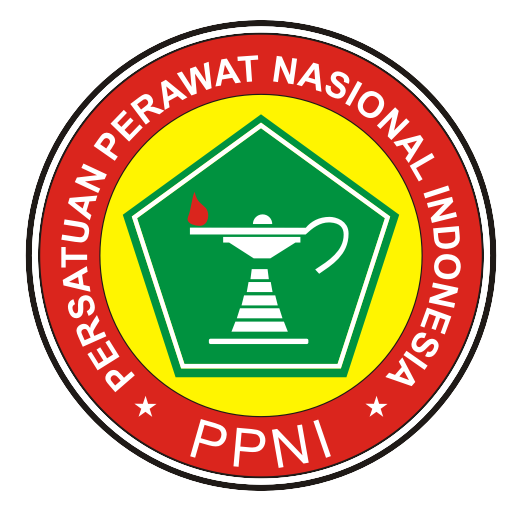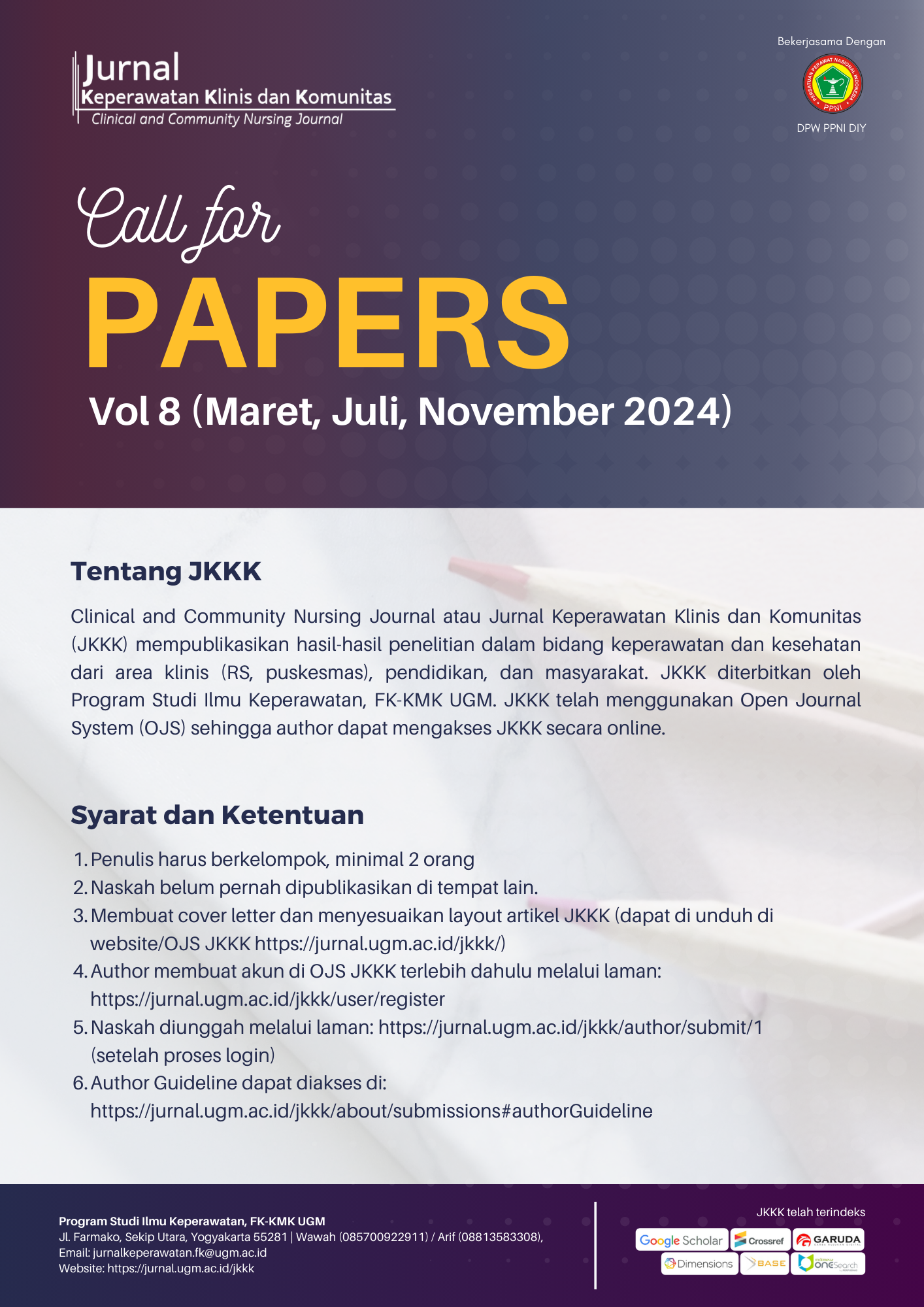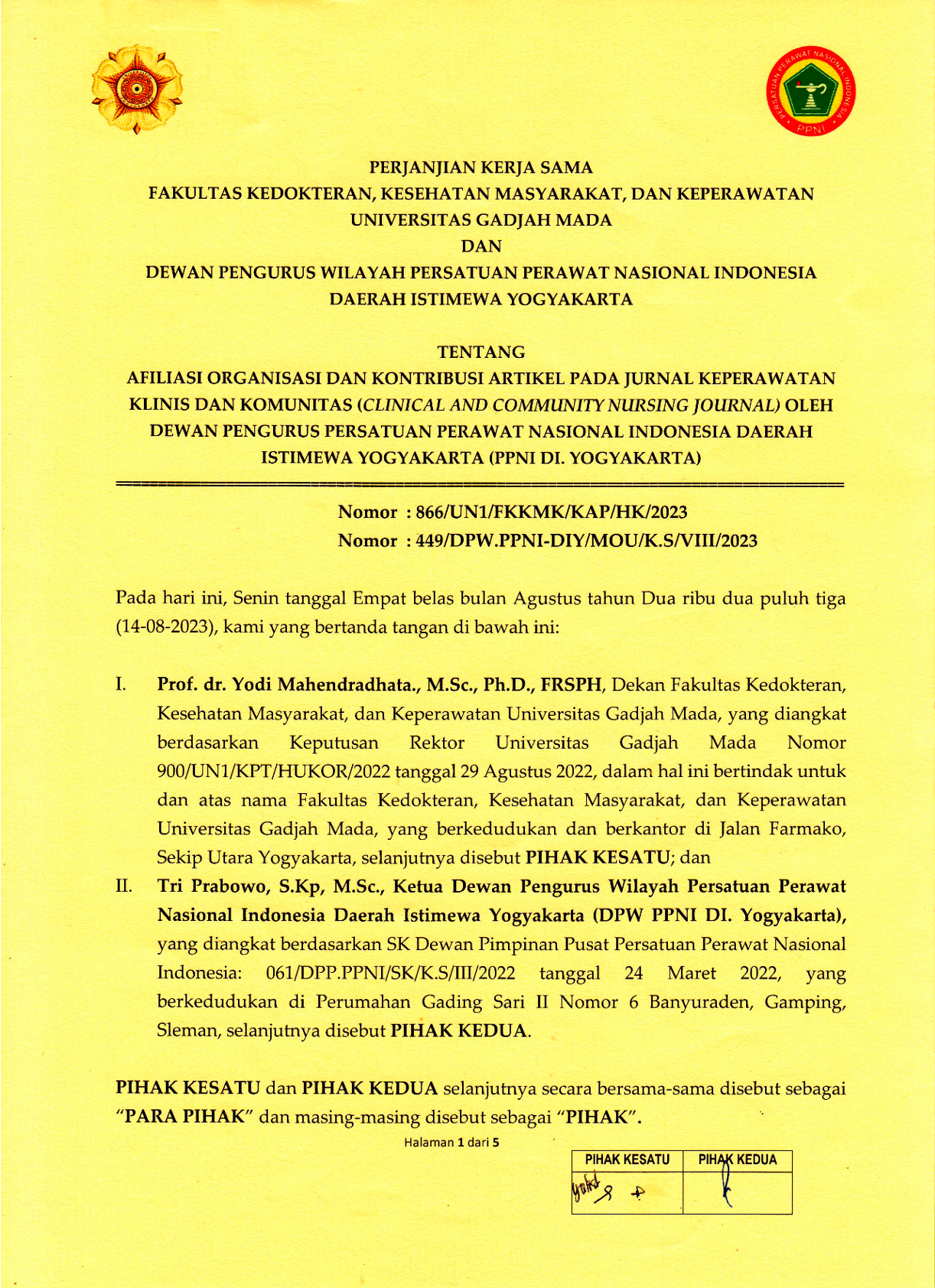Analisis Asuhan Keperawatan pada Pasien Terpasang Canul Trakeostomi dengan Masalah Keperawatan Bersihan Jalan Napas Tidak Efektif dengan Intervensi Fisioterapi Dada di Ruang Mawar RSD dr. Soebandi Jember: Studi Kasus
Tanwirotul Afidah(1*), Murtaqib Murtaqib(2), Suheriyono Suheriyono(3)
(1) Program Studi Profesi Ners, Fakultas Keperawatan, Universitas Jember
(2) Program Studi Ilmu Keperawatan, Fakultas Keperawatan, Universitas Jember
(3) RSD dr. Soebandi Jember
(*) Corresponding Author
Abstract
Background: Maxillofacial fracture is a fracture that refers to the facial skeletal, dentoalveolar bone and related parts within the head and neck area due to external trauma. Severe fractures in the facial bones hinder client’s airway. Tracheostomy is one of the procedures for persistent airway obstruction.
Objective: To analyze nursing care for clients with tracheostomy for indications of maxillofacial fracture with nursing problems in ineffective airway clearance using chest clapping physiotherapy interventions in the Mawar Room, RSD dr. Soebandi Jember.
Case report: The client was admitted to the Hospital due to motorcycle accident. During the assessment the client complained of coughing, tightness, and sleeplessness. After a canul tracheostomy was attached to the client, there were several symptoms, ie.: the client coughed quite frequently, unable to cough effectively, there was a dry ronchi, had difficulty in speaking, and the client's breathing pattern changed. In conclusion, the main nursing problem was ineffective airway clearance.
Outcome: The results of the analysis after chest physiotherapy 3 times for 3 days showed the expected result of chest physiotherapy action, which was the sputum was removed and cleared from the airway. Therefore, oxygen diffusion was optimal, the client's oxygen saturation increased within the normal range, coughing decreased, and insomnia complaints were reduced.
Conclusion: Chest physiotherapy can help remove the client's sputum, thus reduces sputum and ronchi sound, tightness marked with respiration rate (RR) within the normal range, and coughing in clients with nursing problem ineffective airway clearance attached canul tracheostomy.
Latar belakang: Fraktur maksilofasial merupakan fraktur yang mengacu pada skeletal wajah, tulang dentoalveolar dan bagian-bagian yang terkait dalam daerah kepala dan leher karena trauma eksternal. Fraktur pada tulang wajah yang parah menyebabkan pasien tidak dapat mempertahankan jalan napasnya. Trakeostomi merupakan salah satu prosedur untuk obstruksi jalan napas persisten.
Tujuan: Untuk menganalisis asuhan keperawatan pada pasien yang terpasang trakeostomi atas indikasi fraktur maksilofasial dengan masalah keperawatan bersihan jalan napas tidak efektif menggunakan intervensi fisioterapi dada clapping di Ruang Mawar RSD dr. Soebandi Jember.
Laporan kasus: Pasien masuk ke Rumah Sakit karena kecelakaan sepeda motor. Saat dilakukan pengkajian, pasien mengeluh batuk, sesak napas, dan tidak bisa tidur. Terdapat beberapa gejala pada pasien setelah terpasang canul trakeostomi, antara lain batuk cukup sering, tidak mampu melakukan batuk efektif, terdapat ronchi kering, sulit berbicara, dan pola napas pasien berubah, sehingga memiliki masalah keperawatan utama bersihan jalan napas tidak efektif.
Hasil: Hasil analisis setelah dilakukan fisioterapi dada 3 kali selama 3 hari, menunjukkan pencapaian tindakan fisioterapi dada, yaitu dapat mengeluarkan dan membersihkan sputum dari saluran napas, sehingga difusi oksigen optimal, saturasi oksigen pasien meningkat dalam rentang normal, batuk berkurang, dan keluhan susah tidur berkurang.
Simpulan: Fisioterapi dada dapat membantu mengeluarkan sputum pasien, sehingga sputum dan suara ronchi dapat berkurang, sesak napas berkurang ditandai dengan respiration rate (RR) dalam rentang normal, dan batuk dapat berkurang pada pasien dengan masalah keperawatan bersihan jalan napas tidak efektif yang terpasang canul trakeostomi.
Keywords
Full Text:
PDFReferences
- Saleh E. Fraktur Maksila dan Tulang Wajah sebagai Akibat Trauma Kepala. Paper present at: Seminar Handayani Dentistry; 2016 December 2. Yogyakarta: Persatuan Dokter Gigi Indonesia Cabang Gunung Kidul. Available from: http://repository.umy.ac.id/handle/123456789/7384.
- Manalu EE, Buchari FB, Tarigan UA. Relation between the Location of the Mandibular Fracture and the Incidence of Post ORIF Malocclusion in H. Adam Malik Central General Hospital Medan, Indonesia. International Journal of Medical Science and Clinical Invention; 2018; 5(04): 3752-3755. http://dx.doi.org/10.18535/ijmsci/v5i4.08.
- Cheung NH, Napolitano LM. Tracheostomy: Epidemiology, Indications, Timing, Technique, and Outcomes. Respiratory Care. 2014; 59(6): 895–919. https://doi.org/10.4187/respcare.02971.
- PPNI. Standar Diagnosis Keperawatan Indonesia (1st Ed.). Jakarta Selatan: Dewan Pengurus Pusat Persatuan Perawatan Nasional Indonesia; 2017.
- De Sousa VEC, De Oliveira Lopes MV, De Araujo TL, Rolim ILTP, Do Nascimento RV, Oliveira TF. Clinical Indicators of Ineffective Airway Clearance for Patients in The Cardiac Postoperative Period. European Journal of Cardiovascular Nursing. 2013; 12(2): 193–200. https://doi.org/10.1177/1474515112443931.
- Sukma HA, Indriyani P, Ningtyas R. Pengaruh Pelaksanaan Fisioterapi Dada (Clapping) terhadap Bersihan Jalan Napas pada Anak dengan Bronkopneumonia. Journal of Nursing Health. 2020; 5(1): 9–18. https://doi.org/10.52488/jnh.v5i1.112.
- Abdullahi A. Safety and Efficacy of Chest Physiotherapy in Patients with COVID-19: A Critical Review. Frontiers in Medicine. 2020; 7(July): 1–6. https://doi.org/10.3389/fmed.2020.00454.
- Sereearuno T, Rittayamai N, Lawansil S, Thirapatarapong W. Effectiveness of A Chest Physiotherapy Care Map in Hospitalized Patients. Heart Lung. 2020; 49(5): 616–21. https://doi.org/10.1016/j.hrtlng.2020.03.014.
- Spapen HD, Regt J De, Honoré PM. Chest physiotherapy in mechanically ventilated patients without pneumonia-a narrative review. Journal of Thoracic Disease. 2017; 9(1): p. E44–E49. https://doi.org/10.21037/jtd.2017.01.32.
- Chaves GS, Freitas DA, Santino TA, Nogueira PAM, Fregonezi GA. Chest Physiotherapy for Pneumonia in Children. Cochrane Database of Systematic Review. 2019; 2019(1): CD010277. https://doi.org/10.1002%2F14651858.CD010277.pub3.
- Tahir R, Sry Ayu Imalia D, Muhsinah S. Fisioterapi Dada dan Batuk Efektif sebagai Penatalaksanaan Ketidakefektifan Bersihan Jalan Napas pada Pasien TB Paru di RSUD Kota Kendari. Health Information: Jurnal Penelitian. 2019; 11(1): 20–5. https://doi.org/10.36990/hijp.v11i1.87.
- Maimuna S, Supriyanto D, Bahrudin M. Efektivitas Clapping dan Vibrating terhadap Kebersihan (The Effect of Clapping and Vibrating Against The Airway). E-Journal Keperawatan. 2014; 7(2): 59–65. Available from: http://journal.poltekkesdepkes-sby.ac.id/index.php/KEP/article/view/478.
- PPNI. Standar Intervensi Keperawatan Indonesia (1st Ed.). Jakarta Selatan: Dewan Pengurus Pusat Persatuan Perawatan Nasional Indonesia; 2018.
- Widiastuti A, Rahmasari I, Ermawati M, Sani FN. Penerapan Fisioterapi Dada (Postural Drainage, Clapping dan Vibrasi) Efektif untuk Bersihan Jalan Napas pada Anak Usia 6-12 Tahun. 2021; 10(1): 59–65. https://doi.org/10.52236/ih.v10i1.237.
- Kusuma H. Hand Book for Health Student. Yogyakarta: Mediaction Publishing; 2015.
- Nugroho YA, Kristiani EE. Batuk Efektif dalam Pengeluaran Dahak pada Pasien dengan Ketidakefektifan Bersihan Jalan Napas di Instalasi 20 Rehabilitasi Medik Rumah Sakit Baptis Kediri. Jurnal STIKES RS Baptis Kediri. 2011; 4(2). Available from: https://www.neliti.com/publications/210273/batuk-efektif-dalam-pengeluaran-dahak-pada-pasien-dengan-ketidakefektifan-bersih#cite.
Article Metrics
Refbacks
- There are currently no refbacks.
Copyright (c) 2023 Tanwirotul Afidah, Murtaqib Murtaqib, Suheriyono Suheriyono

Jurnal Keperawatan Klinis dan Komunitas (Clinical and Community Nursing Journal)
collaborates with DPW PPNI DIY
![]()
Jurnal Keperawatan Klinis dan Komunitas (Clinical and Community Nursing Journal) is licensed under a Creative Commons Attribution-ShareAlike 4.0 International License.




